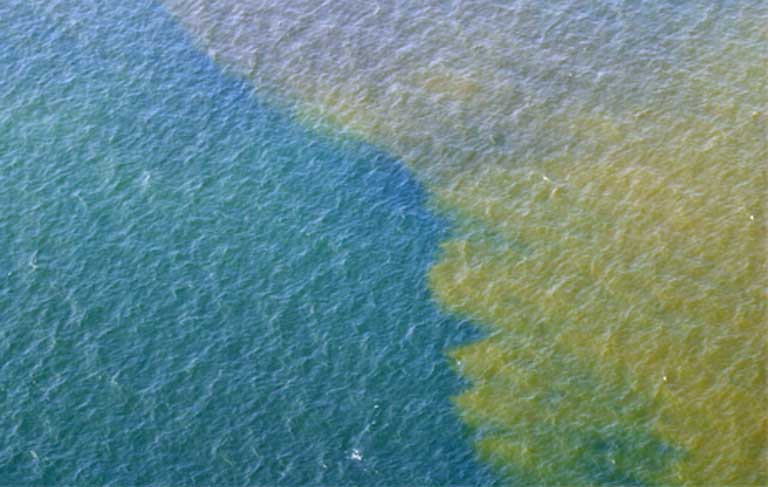- A team of international researchers recently published the first global assessment of harmful algal blooms (HABs) — events in which toxic algae proliferate and cause harm to marine life and humans — based on nearly 10,000 recorded events between 1985 and 2018.
- The study found that there are no global trends that would suggest that climate change is having a uniform impact on HABs throughout the world, although this is a commonly held belief.
- The researchers were able to detect clearer regional trends that showed increases, decreases or no significant changes in HABs in certain parts of the world.
- It also found that there was a perceived increase in HABs amid the booming aquaculture industry, although the study does not necessarily suggest that aquaculture is causing an increase in HABs.
It started in October 2017. A swarm of microscopic algae called Karenia brevis amassed in the waters off Florida’s southwest coast, turning the ocean a rust-red hue. The algae, which are toxic to most marine life as well as humans, transformed Florida’s sea into a watery graveyard as the bodies of fish, manatees, dolphins and turtles washed ashore. The K. brevis didn’t recede until the winter of 2018 and 2019, prompting experts to deem the event, known as a “red tide,” as Florida’s worst in more than a decade.
This red tide was one of thousands of harmful algal blooms (HABs) that occurred in the world’s oceans in the past 35 years. HABs tend to be an issue of concern because of the way they kill off marine life, contaminate seafood, and wreak havoc on local economies. While some HABs are known to occur naturally, others are thought to be triggered by an overabundance of nutrients spilling into the ocean from farms and residential land. Some experts also say that climate change is, and will continue, to make algal blooms even worse.
But according to the authors of a new study published in Nature Communications Earth and Environment, there are no global trends that would suggest that climate change is having a uniform impact on HABs throughout the world.
“If we could have said that there is a clear global trend and it’s increasing everywhere, that would have been a real easy one to communicate,” study co-author Henrik Enevoldsen of the UNESCO Intergovernmental Oceanographic Commission (IOC) Science and Communication Centre on Harmful Algae, told Mongabay. “But what we have learned is that which we knew basically — that it’s a very complex story.”
He added that climate change could be having a direct impact on HABs in some regions, but that global trends do not suggest this is happening everywhere.
The study is the first global assessment of HABs based on global data from two UNESCO data systems, the Harmful Algal Event Database (HAEDAT) and the Ocean Biodiversity Information System. The research team, which involved 109 scientists from 35 countries, examined over 9,500 HABs that happened between 1985 and 2018 to determine the distribution and frequency of HABs.

It ultimately found that regional trends were easier to detect, with HABs found to be increasing in some parts of the world, such as Central and South America, while decreasing in places like Australia and New Zealand and remaining the same in regions such as Europe and Southeast Asia. The variances between these regional trends are most likely driven by the differences in algal species involved in HABs and their impacts on varying types of coastal ecosystems, the paper suggests.
“When you deal with coastal environments, [there are] so many types [of algae] and species that are from so many different groups, deeply different from one another, and also [different] impacts that vary from toxicity to discolorations,” co-author Adriana Zingone of Stazione Zoologica Anton Dohrn in Naples, Italy, told Mongabay. “This is the reason why we’re not so surprised [by our findings]. It’s impossible to see this as a single event or a single phenomenon. It’s a complexity.”
Another key finding of the study is that increased monitoring efforts related to the burgeoning aquaculture industry have generated a “perceived increase in harmful algae events.” However, Zingone says this study does not necessarily suggest that aquaculture is causing an increase in HABs.
According to the study, aquaculture production increased 16-fold during the study period, expanding from a global total of 11.35 million tons in 1985 to 178.5 million tons in 2018.
Enevoldsen says that the study illustrates how large data sets can help improve understanding of a complex issue like HABs, and that he hopes it will encourage more countries to share their data so that scientists can increase their knowledge of this issue.
“If we have better data sets … it is possible to warn better, to forecast better, to protect resources, economies and health,” he said.
Enevoldsen says that the study also shows that HABs are not always triggered by climate change and other human pressures, but can simply be naturally occurring events.
“Not everything in the world … is due to overexploitation and climate change,” he said. “Some [HABs] are more related to the fact that we are everywhere … and then we encounter what has always been there as a part of a natural ecosystem.”
Citation:
Hallegraeff, G. M., Anderson, D. M., Belin, C., Bottein, M. D., Bresnan, E., Chinain, M., … Zingone, A. (2021). Perceived global increase in algal blooms is attributable to intensified monitoring and emerging bloom impacts. Communications Earth & Environment, 2(1). doi:10.1038/s43247-021-00178-8
Banner image caption: A red tide in Iwaki Island in Japan. Image by melvi / Wikimedia Commons (CC BY-SA 4.0).
Elizabeth Claire Alberts is a staff writer for Mongabay. Follow her on Twitter @ECAlberts.
FEEDBACK: Use this form to send a message to the author of this post. If you want to post a public comment, you can do that at the bottom of the page.
